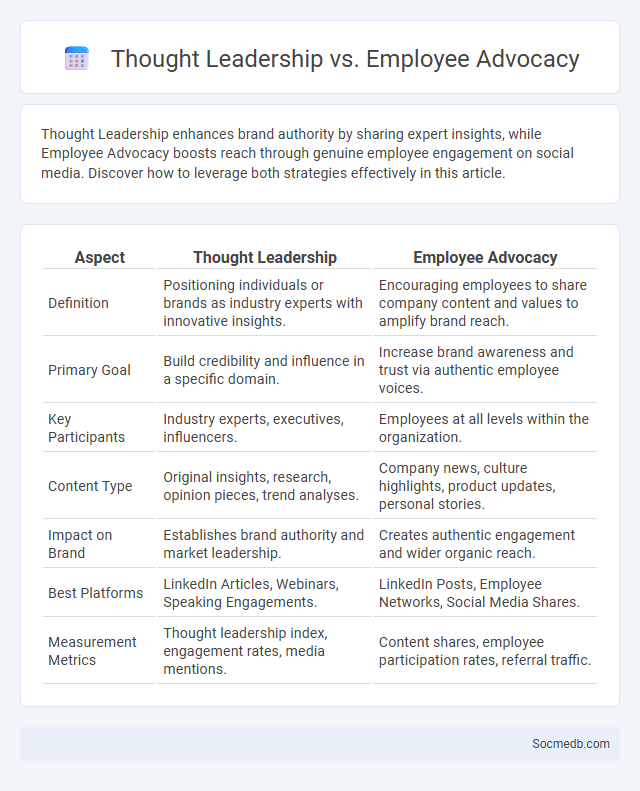
Photo illustration: Thought Leadership vs Employee Advocacy
Thought Leadership enhances brand authority by sharing expert insights, while Employee Advocacy boosts reach through genuine employee engagement on social media. Discover how to leverage both strategies effectively in this article.
Table of Comparison
| Aspect | Thought Leadership | Employee Advocacy |
|---|---|---|
| Definition | Positioning individuals or brands as industry experts with innovative insights. | Encouraging employees to share company content and values to amplify brand reach. |
| Primary Goal | Build credibility and influence in a specific domain. | Increase brand awareness and trust via authentic employee voices. |
| Key Participants | Industry experts, executives, influencers. | Employees at all levels within the organization. |
| Content Type | Original insights, research, opinion pieces, trend analyses. | Company news, culture highlights, product updates, personal stories. |
| Impact on Brand | Establishes brand authority and market leadership. | Creates authentic engagement and wider organic reach. |
| Best Platforms | LinkedIn Articles, Webinars, Speaking Engagements. | LinkedIn Posts, Employee Networks, Social Media Shares. |
| Measurement Metrics | Thought leadership index, engagement rates, media mentions. | Content shares, employee participation rates, referral traffic. |
Understanding Thought Leadership
Thought leadership in social media involves establishing Your brand or personal profile as an expert by consistently sharing insightful, innovative content that resonates with your industry audience. Engaging meaningfully with followers and participating in relevant discussions enhances Your authority and trustworthiness. This strategic approach drives increased visibility, strengthens Your online reputation, and fosters lasting professional relationships.
Defining Employee Advocacy
Employee advocacy is the practice of empowering your employees to promote and represent your brand authentically on social media platforms. This strategy leverages their personal networks to expand brand reach, enhance credibility, and drive engagement by sharing company content, insights, and culture. Effective employee advocacy programs use clear guidelines and training to align messaging with organizational goals while maintaining genuine voices.
Key Differences Between Thought Leadership and Employee Advocacy
Thought leadership involves individuals or brands sharing expert insights to influence industry discourse, while employee advocacy leverages employees to promote company culture and values through personal social media channels. Thought leaders create original, high-value content to establish authority, whereas employee advocates amplify existing company messages to extend reach and credibility. Both strategies enhance brand visibility but target different audiences and utilize distinct content types to drive engagement and trust.
The Benefits of Thought Leadership for Organizations
Thought leadership solidifies an organization's reputation as an industry authority, fostering trust and credibility among target audiences on social media platforms like LinkedIn and Twitter. By sharing expert insights and innovative ideas, companies enhance brand visibility, attract potential clients, and stimulate meaningful engagement. Leveraging thought leadership content drives organic growth, improves SEO rankings, and positions organizations favorably within competitive markets.
How Employee Advocacy Amplifies Brand Voice
Employee advocacy significantly amplifies brand voice by leveraging authentic employee-generated content, which increases trust and engagement across social media platforms. Social media algorithms favor genuine interactions, making employee shares and endorsements more visible, expanding brand reach organically. This authentic brand amplification drives higher conversion rates and strengthens brand reputation in competitive digital landscapes.
Overlap and Synergy: Where Thought Leadership Meets Employee Advocacy
The overlap between thought leadership and employee advocacy creates a powerful synergy that amplifies brand credibility and trust on social media platforms. Employees sharing expert insights and company values enhance authenticity, while thought leaders provide visionary content that drives engagement. This integrated approach fosters deeper connections with target audiences and accelerates organic reach.
Building an Effective Thought Leadership Strategy
Building an effective thought leadership strategy on social media involves consistently sharing insightful content that showcases your expertise and adds value to your target audience. Engaging with industry influencers and participating in relevant conversations amplifies your visibility and credibility across platforms like LinkedIn and Twitter. Your authentic voice and regular contributions position you as a trusted authority, driving meaningful connections and long-term professional growth.
Best Practices for Employee Advocacy Programs
Effective employee advocacy programs leverage authentic content sharing, empowering employees to act as credible brand ambassadors on social media platforms like LinkedIn, Twitter, and Facebook. Providing comprehensive training and clear guidelines ensures consistent messaging while maintaining individual voice and compliance with company policies. Utilizing analytics tools to measure engagement, reach, and conversion rates helps optimize strategies and demonstrates the program's impact on brand awareness and lead generation.
Measuring the Impact: Thought Leadership vs Employee Advocacy
Measuring the impact of social media efforts reveals that thought leadership drives brand authority and industry influence by generating high-quality content that attracts engaged audiences and fosters trust. Employee advocacy amplifies reach and authenticity, leveraging employees' networks to enhance brand visibility and increase organic engagement rates significantly. Combining analytics metrics such as engagement rates, share of voice, lead generation, and sentiment analysis provides a comprehensive view of the distinct contributions from both strategies.
Choosing the Right Approach: Thought Leadership, Employee Advocacy, or Both
Choosing the right social media strategy involves evaluating thought leadership and employee advocacy based on brand goals and audience engagement. Thought leadership enhances brand credibility by showcasing expert insights and industry knowledge, while employee advocacy amplifies reach through authentic, personal endorsements from staff. Combining both approaches maximizes influence, fosters trust, and drives organic growth across social platforms.
 socmedb.com
socmedb.com